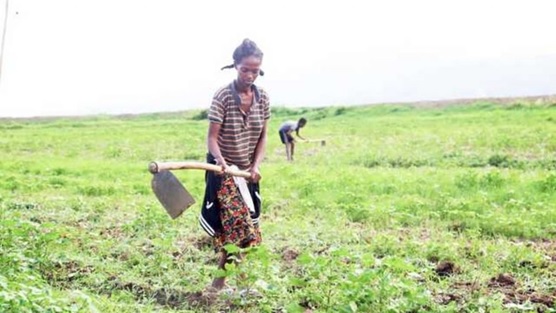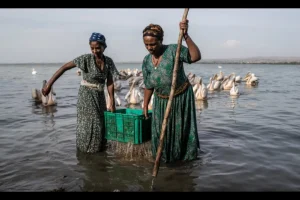
BY MENGESHA AMARE
Not only does Ethiopia enjoy seasoning thirteen months of sunshine but it has also possessed a number of periods which help farmers produce crops twice or thrice even beyond. It is also well recognized that agriculture is the mainstay of Ethiopian economy. Backing the mainstream season to produce all types of crops, the Belg (a short raining minor season) with adequate rains in March may have helped farmers complete Belg season planting of short cycle crops such as barley and wheat.
The Ethiopian Herald approached Abdella Muzein, an agro-economist graduated from Dilla University to have a piece of information about Belg season economic contribution and the parts of the country where this supplementary production season is being well exercised.
He said, “Normally, Belg, short rain season, starts around mid-February and continue through mid-May, with frequent dry enchantments in between. In the Belg-dependent crop producing of the northern highlands that have mostly black cotton soils, alternating periods of wet and dry weather are particularly useful as these soils tend to simply become waterlogged.”
Sometimes an early start to the Belg season characterized by light to moderately heavy rains during the first half of January. The light showers lasting two to three days covered most of the Belg crop-producing areas in central and southern parts of the country. Towards the end of February, the rains increased in amount and geographic spread, Abdella added.
As to him, as widespread and significant rainfall fell during the first weeks of March, there has been near-normal rainfall in the Belg-producing areas of some parts of the country. The rains are much above normal in the Belg-producing areas of North Omo and the pastoral lowlands of Borena and South Omo Zones.
Below-normal rainfall is also sometimes observed in the predominantly Meher-dependent East Shewa, East Hararghe and West Hararghe Zones where long cycle crops planted in the Belg season and reach maturity in the main season.
True, adequate rains in March may have helped farmers to complete planting of Belg crops, such as teff, even at lower altitudes. Furthermore, these rains may have also prompted farmers to start planting long-cycle crops (maize and sorghum) that reach maturity during the Meher season, he added.
Abdella further stated that it is quite obvious that Ethiopia’s crop agriculture is complex, involving substantial variation in crops grown across the country’s different regional states and ecologies. Its crop agriculture thus continues to be dominated by the country’s numerous small farms that cultivate mainly cereals for both own-consumption and sales: smallholders account for more than ninety percent of total area cultivated. The five major cereals namely barley, sorghum, maize, teff and wheat occupy almost three-quarters of total area cultivated, and represent almost 70 percent of total value added in the nation.
The Belg seasonal rainfall normally peaks during April/May and is the main rainy season for the pastoral and agro-pastoral areas of south and southeastern parts of the country, including Afar, Southern Somali, and the lowlands of Borena, Guji and Bale zones of Oromia Regional state, he stated.
He said, “Belg rains are crucially important for growing Belg crops in the central, southern and eastern areas. Although Belg crops contribute less than ten percent of the total grain production, and planting of long-cycle cereal crops such as Sorghum and Millet, replenishment of pasture and drinking water for livestock in both crop dependent, pastoralist and agro-pastoralist areas as well as crop and livestock production in south and south-eastern parts of the country needs to be taken into account.”
Though the rains were initially inadequate and erratic, he said an improvement in rainfall patterns since early March over most areas has been observed. Usually farmers plough twice before planting their Belg crops. With the relatively late onset of the Belg rains it could be expected that preparation of the fields would suffer a delay as well, and the delay has been more distinct in the northern parts of the country and more pronounced in planting areas at higher altitudes.
Consequently, for much of the Belg crop producing area there is a high risk that the harvest will coincide with the peak of the Meher rainy season. This might result in smaller yields and in problems threshing cereals that are not dry enough, he said.
According to Abdella, the comparatively good start to the Belg season followed by generally normal rainfall patterns over most parts of the north-central highlands have contributed much to the improvement of pasture, drinking water and the physical condition of livestock.
Obviously, he further elucidated the importance of Belg rains for land preparation ahead of the Meher season is under-estimated. Long-cycle crops like maize, sorghum, millet, which are planted before the onset of the Meher rains, account for more than 35 per cent of the total grain production in the country. These varieties are much higher in yield than short-cycle cereals.
Despite the erratic character of the Belg rains in some circumstances, there has been no dramatic change in the way people in Ethiopia are farming. A shift from high yielding long-cycle crops to relatively low yielding short-cycle cereals has been noted, however, this being viewed more as a coping mechanism than a conscious change to a different farming strategy. Apart from the vagaries of the climate, an infestation of sorghum chaffer in recent years has also been a factor forcing farmers to shift from the more vulnerable long-cycle crops to relatively more robust but low yielding short-cycle cereals. The moment the climate returns to more normal pattern farmers are expected to revert to their usual crops and planting schedules, he explained.
The most noticeable change has been a greater willingness to expand the area of land under irrigation. At present, there is an impressive tendency to manage water better during rainy periods but more needs to be done to develop the potential for small scale irrigation projects that prolong the availability of water and utilize water resources better. Such projects, however, generally require financing and technical expertise that is usually beyond the means of these farmers.
Given the continuing fragility of livelihoods in Belg-growing and Belg-dependant areas of the Ethiopian highlands, it is important to conduct observation visits to all Belg producing areas in Ethiopia, follow up activities, file the progress of the season in late April or early May so as to help farmers avoid erroneous approaches and sustain positive steps with a view to boosting productivity in Belg season.
As to him, in order to maintain the production of crops during Belg season, incorporating marketing advice to farmers in agricultural extension, revitalizing and expanding a public grain market information system, expanding rural road infrastructure and promoting cross-border trade are quite crucial.
Abdella also elucidated that the Belg crops have been reaped particularly in Oromia, Somali and Amhara Regional States based on land use, soil type, climate and agricultural land, among others. Here, the impact of soil texture and other quite relevant driving forces have to be taken into account during Belg production.
Abdella wrapped up his comment stating that the Belg season in Ethiopia stretches from February to June and contributes 50-65 percent of the annual rainfall for the south-southeastern and up to 40 percent to the northeastern-eastern parts of the country. Hence, Ethiopia has to capitalize on properly exploiting the production opportunities during the Belg season as it plays an indispensible role in well backing the efforts exerted to reinvigorate production and productivity
The Ethiopian Herald January 19/2023




